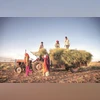The sowing of kharif crops till last week continued to be better than what it was last year as the monsoon picked up pace in July.
Companies manufacturing agricultural inputs are expecting 10-20 per cent growth in sales this season.
According to the latest data, till July 5, sowing was completed in around 38 million hectares, which is over 14 per cent more than the area covered during the same period last year.
The biggest jump in acreage so far has been in pulses (arhar or tur) and oilseeds (soybean).
If this sustains through the season and if other varieties of pulses and oilseeds, such as urad and groundnut, show a better performance, final production should get a boost.
Healthy output in pulses and oilseeds in the kharif season should lower import dependence and control food inflation. A big variable here is the weather, particularly in the period the crops grow.
More From This Section
Good rain has filled the dry reservoirs.
“This kharif season, the early onset of the monsoon, coupled with the forecast of good rain, is expected to boost the sales and demand for plant chemicals. Farmers are likely to increase acreage, particularly for crops such as rice, soybean, and cotton,” Tirth Shah, executive director of GSP Crop Science, told Business Standard.
He said industry projections suggested the overall market for agrochemicals could see a growth rate of 15-20 per cent this season (kharif) over the previous year.
Last year, according to Shah, the domestic agrochemicals sector recorded sales of about Rs 30,000 crore, and this year, the segment is expected to touch around Rs 35,000 crore.
Ankur Aggarwal, managing director, Crystal Crop Protection, said given the signals in the season, he expected a 10-11 per cent increase in demand due to the surge in demand for seeds and crop-protection products.
Analysts tracking the fertiliser sector say sales this year will clock a robust growth rate of 1-3 per cent as was the trend in FY24 as well.
In FY24, 60-61 million tonnes of fertilisers are estimated to have been used in the country.
The monsoon in the country till July 8 was 2 per cent more than normal. Rain in North-West India was 11 per cent more than normal while it was 13 per cent more in the southern peninsula.
Of the 36 subdivisions, 21 received normal rainfall and seven states were in the deficient zone.
“A major portion of sowing occurs during the July and August period. Coming weeks remain crucial in terms of distribution of rainfall and the impact of the same will be reflected on kharif sowing,” Bank of Baroda said in a research note.
)